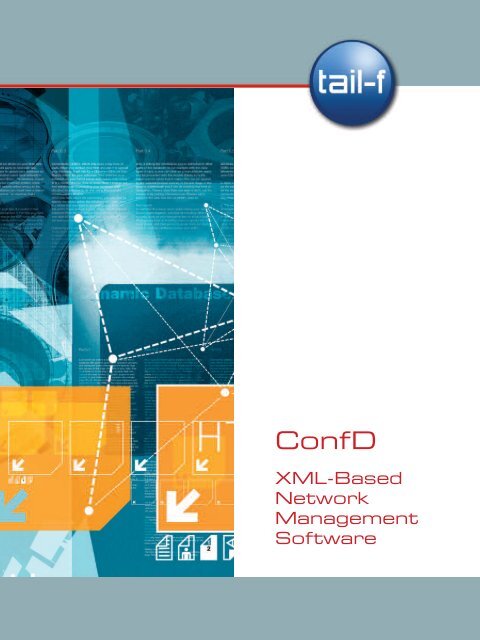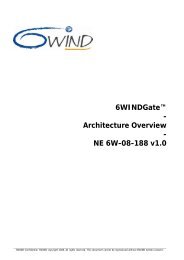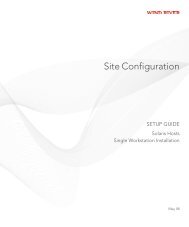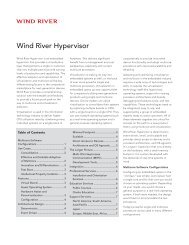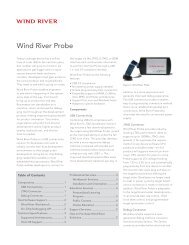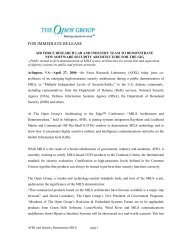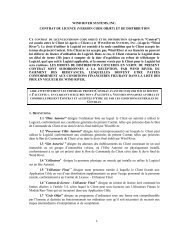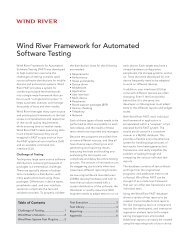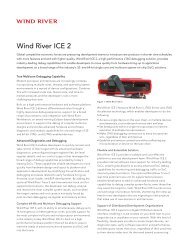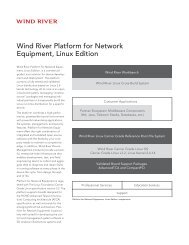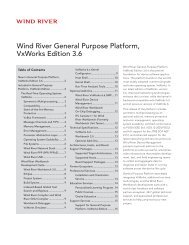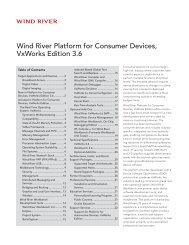ConfD - Wind River
ConfD - Wind River
ConfD - Wind River
You also want an ePaper? Increase the reach of your titles
YUMPU automatically turns print PDFs into web optimized ePapers that Google loves.
<strong>ConfD</strong><br />
XML-Based<br />
Network<br />
Management<br />
Software
Next-Generation Configuration<br />
Management<br />
The increasing complexity of operator and<br />
enterprise networks and the requirement<br />
to deliver new services is driving the need<br />
for improved configuration management<br />
systems. Network operators can no longer<br />
afford to manually provision their networks.<br />
Automated configuration management is<br />
needed to reduce costs, increase reliability,<br />
and respond to customer demands.<br />
<strong>ConfD</strong> provides the industry-leading<br />
implementation of NETCONF to ensure that<br />
configuration changes are uniformly rolled<br />
out and as a result networking solutions are<br />
truly scalable. The NETCONF standard is<br />
now supported by many leading suppliers<br />
of networking equipment and is becoming<br />
a requirement for users of large networks.<br />
Carrier and Enterprise-Class<br />
Implementations<br />
<strong>ConfD</strong> is designed to meet the performance,<br />
scalability, redundancy, and security needs<br />
of carrier and enterprise-class network management<br />
systems. Such capabilities include:<br />
• Transaction management<br />
• Session management<br />
• Audit trailing<br />
• Role-based access control<br />
• Authentication over RADIUS and LDAP<br />
• Extensible schema validation<br />
• Rollback management<br />
• Replication and High-Availability<br />
High performance and scalability are crucial<br />
in large systems. <strong>ConfD</strong> uses its own parsing<br />
algorithm that streams XML data to ensure<br />
that memory usage is bounded. Its embedded<br />
database is optimized to allow very<br />
efficient operations on binary encoded XML<br />
data structures.<br />
Faster and More Affordable<br />
Development<br />
<strong>ConfD</strong> radically reduces the time and resources<br />
needed to develop network management<br />
applications, helping developers to meet<br />
critical market deadlines.<br />
<strong>ConfD</strong> allows developers to describe a data<br />
model for their system once and then, using<br />
a unique technology, to automatically render<br />
CLI, Web, SNMP, and NETCONF interfaces.<br />
Tail-f Systems provides extensive ready to<br />
use libraries of XML specifications and C<br />
instrumentation code for many of the features<br />
expected in a networking device.<br />
In addition to speeding time-to-market, <strong>ConfD</strong><br />
reduces the cost and time involved in maintaining<br />
and supporting applications. <strong>ConfD</strong> allows<br />
NETCONF, CLI, Web, and SNMP interfaces to<br />
use a single set of core functionality, including<br />
a configuration database, and share one set of<br />
common instrumentation functions, thereby<br />
avoiding the tedious recoding efforts required<br />
by legacy stovepipe architectures.<br />
In the “Stove Pipe” approach, management<br />
interfaces connect directly to the Managed<br />
Objects (MOs). The Tail-f approach separates the<br />
management interfaces and back-end system.
<strong>ConfD</strong> Overview<br />
<strong>ConfD</strong> is an XML-based software solution<br />
for on-device configuration management<br />
consisting of the following key components:<br />
• Shared backplane, called the <strong>ConfD</strong><br />
Core Engine<br />
• Northbound management interfaces<br />
(NETCONF, Web UI, CLI, and SNMP)<br />
• Embedded configuration database<br />
The <strong>ConfD</strong> Core Engine connects configuration<br />
and operational data on the device to all<br />
management interfaces through a transactionoriented<br />
API. The Core Engine contains all<br />
functionality common to the management<br />
interfaces, including transaction management<br />
and AAA.<br />
All management interfaces are automatically<br />
rendered from an expressive XML data model.<br />
This radically reduces development time and<br />
allows developers to immediately start<br />
using <strong>ConfD</strong> for internal demonstrations<br />
and prototyping.<br />
NETCONF Interface<br />
The NETCONF protocol provides mechanisms<br />
to install, manipulate, and delete configuration<br />
data on network devices. It uses XML-based<br />
data encoding for the configuration data as<br />
well as for protocol messages. NETCONF is<br />
increasingly required by network operators to<br />
configure and provision large networks in an<br />
efficient and reliable fashion.<br />
The <strong>ConfD</strong> NETCONF Interface implements<br />
the full set of features described in IETF<br />
RFCs 4741 and 4742, including support for<br />
transactions, validations, confirmed commits,<br />
rollbacks, event notifications, partial locking<br />
and XPath filtering.<br />
Web User Interface<br />
<strong>ConfD</strong>’s Web UI enables the rapid development<br />
of modern, dynamic, and graphical network<br />
management applications. The Web Interface<br />
leverages AJAX web development technology<br />
and the look and feel of the UI is defined with<br />
Cascading Style Sheets (CSS) to allow full<br />
freedom for developers to ensure alignment<br />
with branding guidelines. <strong>ConfD</strong> includes an<br />
integrated lightweight web server with support<br />
for HTTP and HTTPS.<br />
Command Line Interface<br />
The <strong>ConfD</strong> CLI provides both Juniper-style<br />
and Cisco-style command line environments<br />
with all the well-known features and idioms<br />
from these CLIs. This includes powerful features<br />
like command line editing, keyboard shortcuts,<br />
and command history. New commands and<br />
wizards can be added as needed.<br />
SNMP Agent<br />
The SNMP Agent supports SNMP v1, v2c, and<br />
v3. It is completely integrated with the <strong>ConfD</strong>’s<br />
XML-based Core Engine. <strong>ConfD</strong> also provides<br />
tools to translate between SNMP MIBs and<br />
XML data models.<br />
Embedded Database<br />
<strong>ConfD</strong>’s Embedded Database provides fast,<br />
lightweight access to configuration and<br />
operational data. Optimized for efficiently<br />
storing and retrieving binary encoded XML<br />
data, the database scales to the performance<br />
levels required by very large networks. The<br />
database supports data replication, providing<br />
high-availability operation.
<strong>ConfD</strong><br />
EMS/OSS<br />
NETCONF SNMP CLI Web UI Other Agent<br />
<strong>ConfD</strong> Core Engine<br />
- Role-based Access Control - Authentication<br />
- Transaction Management - Audit Trailing<br />
- Rollback Management - High Availability<br />
- Session Management - Configuration Validation<br />
Replicated XML Database<br />
Managed Object API<br />
MO MO<br />
Management Agent API<br />
Other Database<br />
MO MO<br />
Data Provider API<br />
Operational Data<br />
- Counters<br />
- Alarms<br />
- Statistics
Flexible Deployment<br />
<strong>ConfD</strong>'s modular architecture provides<br />
designers the flexibility to employ some<br />
or all of its components in developing new<br />
on-device management systems or extending<br />
existing ones.<br />
Developing a New System<br />
<strong>ConfD</strong> provides all the components needed<br />
to rapidly build state-of-the-art network<br />
management applications. Developers need<br />
only develop a single data model of the system<br />
and write instrumentation code once to provide<br />
support for all management interfaces.<br />
Extending an Existing System<br />
An existing network management system<br />
may already have one or several northbound<br />
interfaces, such as CLI and SNMP Agents,<br />
but needs to add new management interfaces,<br />
such as NETCONF and Web UI, in response<br />
to customer demands. <strong>ConfD</strong> has rich APIs<br />
designed for integrating new software with<br />
existing interfaces and data stores.<br />
Unifying Disparate Systems<br />
In legacy product lines, it is common for<br />
each member of a product family to have<br />
a unique adapter or network management<br />
API. <strong>ConfD</strong> enables equipment suppliers<br />
to streamline the development of multiple<br />
devices in a product family by removing<br />
silos of development and standardizing all<br />
parameters on a common XML data model.<br />
This leads to reduced development time<br />
and costs for both on-device and element<br />
management systems.<br />
Supported Platforms<br />
• Linux<br />
• NetBSD<br />
• FreeBSD<br />
• QNX<br />
• Solaris<br />
Examples of Devices<br />
Suitable for <strong>ConfD</strong><br />
• Routers<br />
• Switches<br />
• Security appliances<br />
• Base stations<br />
• Gateways<br />
• DSLAMs<br />
• Network controllers<br />
• IMS control nodes<br />
• Chassis-based products<br />
• Stackable appliances<br />
• Blade server products
Tail-f Systems is the leading developer of<br />
XML-based network management software<br />
for network equipment suppliers. Customers<br />
using Tail-f Systems’ technology radically<br />
reduce their time-to-market and benefit from<br />
carrier-grade implementations of NETCONF,<br />
Web, CLI, and SNMP interfaces.<br />
European Headquarters<br />
Klara Norra Kyrkogata 31<br />
SE-111 22 Stockholm<br />
Sweden<br />
Phone: +46 8 21 37 40<br />
North American Headquarters<br />
109 S. King Street, Suite 4<br />
Leesburg, VA 20175<br />
USA<br />
Phone: +1 703 777 1936<br />
info@tail-f.com<br />
www.tail-f.com


